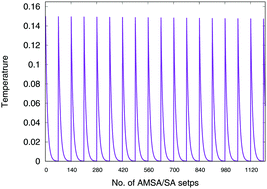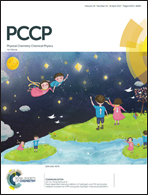An adaptive mutation simulated annealing based investigation of Coulombic explosion and identification of dissociation patterns in (CO2)n2+ clusters†
Abstract
In this communication, we would like to discuss the advantages of adaptive mutation simulated annealing (AMSA) over standard simulated annealing (SA) in studying the Coulombic explosion of (CO2)n2+ clusters for n = 20–68, where ‘n’ is the size of the cluster. We have demonstrated how AMSA itself can overcome the predicaments which can arise in conventional SA and carry out the search for better results by adapting the parameters (only when needed) dynamically during the simulations so that the search process can come out of high energy basins and not go astray for better exploration and convergence, respectively. This technique also has in-built properties for getting more than one minimum in a single run. For a (CO2)n2+ cluster system we have found the critical limit to be n = 43, above which the attractive forces between individual units become greater in value than that of the large repulsive forces and the clusters stay intact as the energetically favoured isomers. This result is in good concurrence with earlier studies. Moreover, we have studied the fragmentation patterns for the entire size range and we have found fission type fragmentation as the favoured mechanism nearly for all sizes.



 Please wait while we load your content...
Please wait while we load your content...